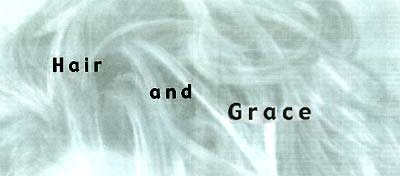|
|
 HAIR AND GRACE
Richard Stein
riginally this piece was to be called "Hair and Aging," but to me the word "aging" has acquired unfortunate cultural connotations. Even in this hopeful new millennium, most fashion and beauty magazines, and their all-important advertisers, have continued stubbornly to write off anyone over thirty-five, preferring to maintain the myth of the Youth Culture. With age should come wisdom, serenity, and grace. Yet even extensive experience with ones hair over the years does not necessarily afford laser insight into its possibilities. On the contrary, a cherished hairstyle can actually blind a woman to new hair horizons, effectively imprisoning her in a kind of style time warp -trendy at thirty, dated at forty. And as for the fifties, nothing so preoccupies most women poised on the cusp of the half-century than that plaguey question: to gray or not to gray. The belief that gray hair ages a woman is deeply embedded in the collective unconscious. We are bombarded by those beguiling TV ads, with beautiful, perennially-young models, telling us that getting rid of the gray is just a shampoo away. The subliminal message is seductive. Simply coloring our hair will subtract any number of years from our calendar and stymie the dread aging process, keeping time at bay. The whole issue of color is a complicated one, but my own position is clear. For the most part I do not encourage people to do it unless it's a career necessity (for actors, for politicians, for spokespeople). Coloring has a profound impact, both physical and psychological. Physically, it's "once colored, long-time colored." It can seem to take forever for an unfortunate new hue to grow out. Psychologically, it's obsession time. Was or wasn't it the right decision in the first place? I'm convinced that the silhouette -the way the hair is shaped to the dimension of the head - is the crucial element in a successful hairstyle. Still, even I'll admit that coloring can be an added adornment to beautifully-cut hair, but it's important for both stylist and client to bear in mind that the true art of color lies in subtlety. Often ones color looks best on the eve of redoing. It's then that I encourage a woman to be patient. Just wait a little longer. Let a new hair cut complement the old color to produce a fresh effect. That stubborn hobgoblin, consistency, dictates sticking with a tried and true look, but when a woman learns more about her particular style range, as she matures -dare I say "ages?" I do! -she may also gain the confidence to experiment -even if that means not using any color at all. The beauty and grace of the aging process is the ability to see ourselves in a new way -as a work-in-creative-progress -and not to be hurried into changing for the sake of change. As a woman's relationship with her hair evolves over time, hopefully, so does her comfort level. With self-knowledge and self-confidence comes courage. The challenge to sympathetic stylist and courageous client, working and communicating in harmony, becomes creating a distinctive hairstyle, a highly personal and flexible look, one tethered to a woman’s accurate sense of herself – of her uniqueness – and not to the look of the day. |